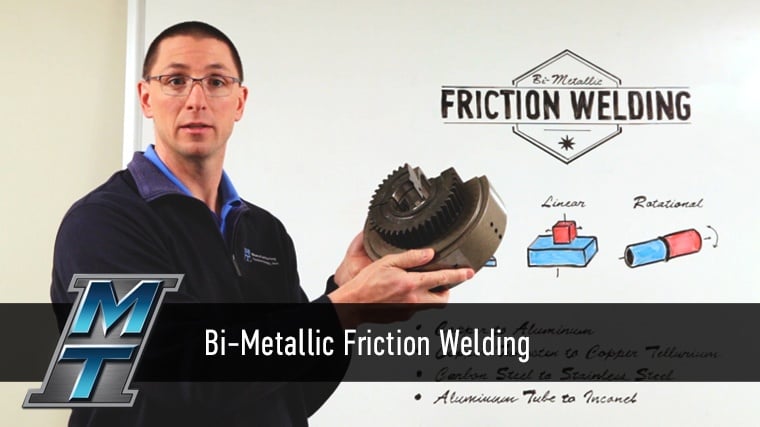One of the key differentiators between friction welding and other welding techniques is the ability to join dissimilar metals or two different materials that may be impossible to join by other techniques. Doing so is a cost effective way of getting the benefits from both materials. Typically we can use any of the friction welding technologies to weld dissimilar metals, and the following are some common bi-metallic combinations and applications:
- Copper & Aluminum – Using linear friction welding, we can join copper to aluminum to form a heat plate. We want the heat transfer properties of the copper but copper doesn’t mount to other surfaces very well or very rigidly, so we weld it to the aluminum so that the aluminum can be used as the mounting surface.
- Copper & Copper – For electrical conductivity, we can use two different types of copper. A softer copper alloy that is much less expensive can be mounted to a harder copper alloy using rotary friction welding. Since the harder alloy is more expensive, you can selectively put it only in the spots where it is needed — where there will be wear characteristics on the finished part.
- Carbon Steel & Stainless Steel – A submersible pump motor with a bi-metallic motor shaft needs the magnetic properties of a carbon steel but also the corrosive resistant properties of a stainless steel.
- Heat Resistant Steel & Wear Resistant Steel – Engine valves, such as high-stressed exhaust valves, utilize rotary friction welding to bond heat resistant steel for the valve head with the abrasive wear resistant steel for the valve stem.
- Aluminum & Inconel – For rocket transition points, it is absolutely critical to have a leak-proof joint between two different materials. Instead of using a mechanical joint, friction welding offers a simpler and dependable alternative.
- Gear Steel & Standard Steel – In certain applications, it is necessary to have a gear mounted to a steel cylindrical base. For parts such as this, manufacturing the part as an assembly is not cost effective. It is much easier to cut the gear teeth before welding, then weld the two materials together.
These examples show how beneficial the ability of friction welding bi-metallic parts can be. We have the flexibility of choosing a specific metal to take advantage of its unique properties ranging from electrical conductivity, to heat resistance, to corrosive resistance – and combine it with another metal with its own beneficial properties. Also, bi-metallic parts allow us to put the expensive materials only where they are needed. This allows us to make cost-effective, high-performance parts.
{{cta(‘a7e5e87d-70e5-40e9-9517-660a2e679874′,’justifycenter’)}}

MTI Can Solve Your Problems
As you can see, MTI offers the unique ability to truly customize parts that will best serve your applications and save you money at the same time. Talk with our expert engineers today to identify your needs and let us design a specialized solution for you. We’ll build a machine that makes your part, we’ll make the part for you, or we’ll help you make the part even better.
To learn more about friction welding, view our process or watch how friction welding can be put to work for you.
